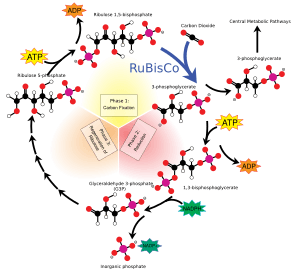Light-independent reaction facts for kids
In photosynthesis, plants use sunlight to make their own food. This amazing process happens in two main steps. First, there are light-dependent reactions that need sunlight directly. Then, there are light-independent reactions, which don't need light directly, but they use the energy gathered from the first step.
These light-independent reactions happen inside tiny parts of plant cells called chloroplasts. Their main job is to turn carbon dioxide from the air into sugars. These sugars are the plant's food!
The whole process of making sugar from carbon dioxide is called the Calvin cycle. It uses special energy packets called ATP and NADPH. These energy packets are created during the light-dependent reactions. The Calvin cycle also needs helper molecules called enzymes to work properly. So, even though it's "light-independent," it still relies on the energy made when there is light.
Once the sugars are made, the plant moves them to different parts of itself. This movement is called translocation. The Calvin cycle happens in a part of the chloroplast called the stroma. It's an anaerobic process, which means it doesn't use oxygen.
Contents
How the Calvin Cycle Works
The Calvin cycle is a bit like a factory assembly line that builds sugar. Here's how it generally works:
Step 1: Carbon Fixation
- A special 5-carbon sugar molecule, called Ribulose Biphosphate (or RuBP), is waiting in the plant.
- It grabs a molecule of carbon dioxide from the air.
- With the help of an important enzyme called RuBisCO, these two molecules combine.
- They form a new, unstable 6-carbon sugar. This quickly breaks down into two 3-carbon molecules called phosphoglycerate.
Step 2: Reduction
- The phosphoglycerate molecules get energy from ATP and hydrogen atoms from NADPH.
- This process changes them into two new 3-carbon molecules called triose phosphate. Think of it as adding energy and building blocks to make them more useful.
Step 3: Regeneration and Sugar Production
- Most of the triose phosphate molecules are used to make more Ribulose Biphosphate (RuBP). This uses more ATP.
- This step is super important because it keeps the "cycle" going, so the plant can keep making sugar.
- The remaining triose phosphate molecules are used to build bigger sugars, like glucose. Glucose is the main food source for the plant.
See also
 In Spanish: Ciclo de Calvin para niños
In Spanish: Ciclo de Calvin para niños


